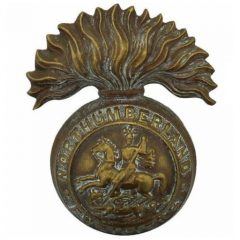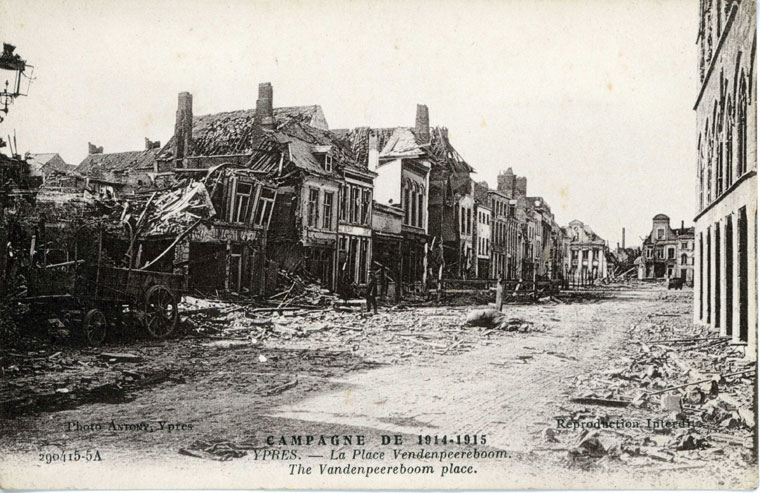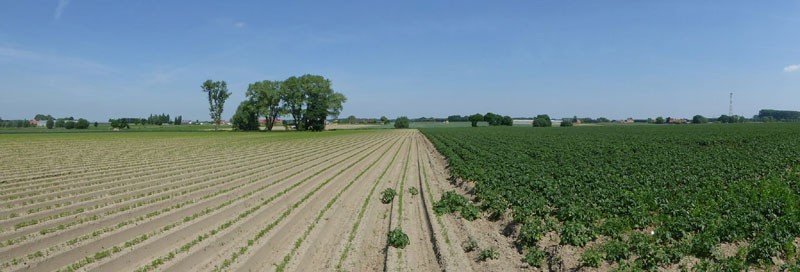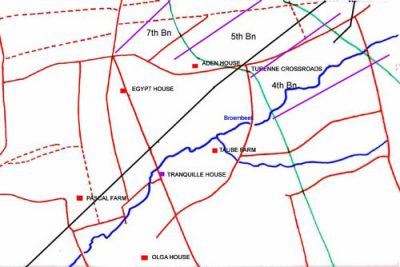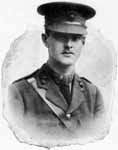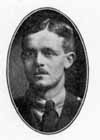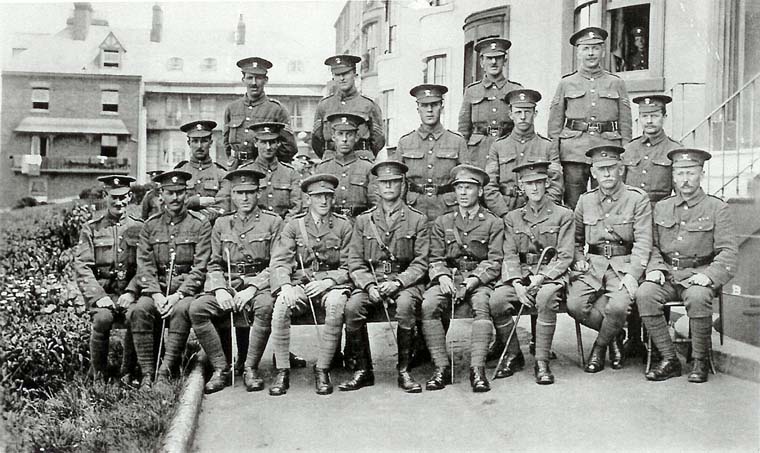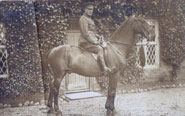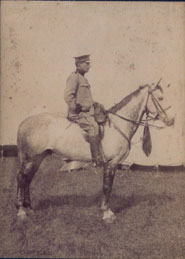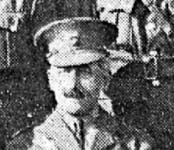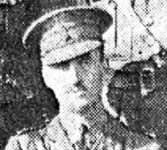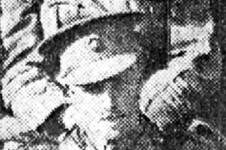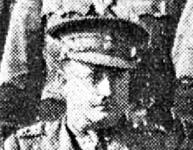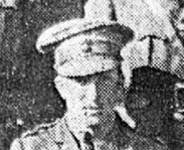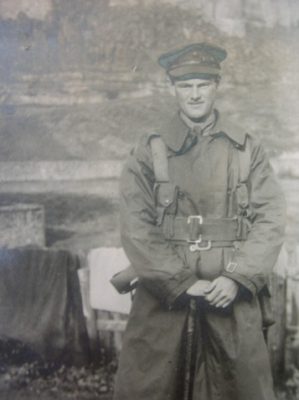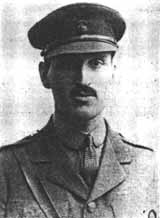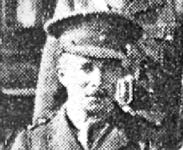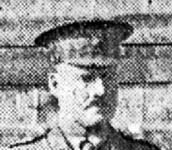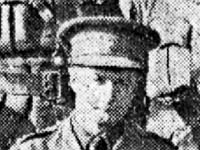4th Battalion War Diary
APPENDIX X A
OPERATION ORDER NO. 1A.
1. The 149th Infantry Bde will attack on the morning of the 26th inst, 4th NF on the right, 5th NF in centre and 7th NF on left, - 57th Div are attacking on our right, with 4th/5th Loyal North Lancs as their left battalion.
2. The battalion will attack on a 3 company frontage each company being on a platoon frontage.
‘A’ company on right, ‘B’ company in centre and ‘D’ company on left. ‘C’ Company will be in reserve on a 2 platoon frontage.
3. (a) Platoons will leap frog and capture and consolidate the objectives already given them i.e. FIRST WAVE to HUTS, SECOND WAVE to line V.2.3.1.6 – V.2.c.5.1. THIRD WAVE to final objective V.2.a.3.0 to V.2.d.15.55.
(b) Reserve company will move forward with attacking waves to a point approximately 200 yards west of the HUTS.
(c) ‘A’ company will detail parties to obtain touch with battalion on their right at the following points.
(a) Concrete shelter at V.8.a.1.8.
(b) Ditto at V.2.c.4.1.
(c) ROAD BRIDGE at V.2.d.0.6.
4. Two machine guns will accompany 4th wave of ‘B’ Company.
5. Two Stokes Mortars will be attached to ‘C’ company and will be available to fire at any strong points holding up the attack.
6. Barrage will begin to creep forward at ZERO + 8 minutes and will creep at the uniform rate of 100 yards in 8 minutes throughout. Lifts will be at 50 yards at a time.
7. Taping out of the assembly trench will be carried out under an officer from Battalion HQ. One line of tape will be laid from the Railway Embankment at point V.1.d.0.2. to V.7.b.6.5. Two guides will be left at the end of the tape on Railway Embankment. A short length of tape will be laid at right angles to assembly tape to mark the left of ‘D’ company, short lengths of tape will be laid at right angles to assembly tape every 130 yards to mark company frontages. The assembly tape marks position of leading wave.
8. ‘A’,’C’ and ‘D’ companies will move forward to assembly positions at 7pm tonight each company providing its own covering party. ‘B’ company will withdraw to the assembly tape at 11pm. Completion of assembly will be notified by code word ARRAS, sent by runner to battalion HQ.
9. 1 contact aeroplane will be flying over companies front at zero + 1 hour 30 mins and at zero + 3 hours heading troops will show their position to contact aeroplane only when called for
(a) by Claxon horn
(b) by series of white Very lights dropped from the plane.
10. RAP will be at PASCHAL FARM 1.
11. PRISONERS 1 man as escort to 5 Bosches
12. Reports will be forwarded to battalion HQ at TAUBE FARM as frequently as possible and at least once in the first hour after zero.
13. Battalion HQ will open at TAUBE FARM at 7pm tonight.
14. Zero will be at the fall of the barrage. Time of this will be notified later, also synchronisation of watches.
15. General compass bearing of attack 55 degrees magnetic.
16. Acknowledge.
Issued at 1.30 pm
Copies to CO ‘A’, ‘B’, ‘C’ and ‘D’.
4th Battalion War Diary
CORRIGENDA TO OPERATION ORDER NO 1A
1. Owing to the swampy state of the ground on the right of our attack, it has been decided to attack on a 2 Coy frontage instead of a 3 Coy frontage. ‘B’, ’C’ and ‘D’ companies will have dispositions exactly as laid down in O.O. no 1A.
2. ‘A’ company will NOT go to the assembly tape but will move from TRANQUILLE HOUSE to TAUBE FARM at 9pm tonight, when they will be in battalion reserve.
3. Hot tea and rum will be brought up tonight 1 guide per company to be at TAUBE FARM at 11pm to guide carrying parties.
4. Acknowledge.
Issued at 2pm
Copies to CO, ‘A’,’B’,’C’ and ‘D’
The CO reported the change to Bde HQ:
Summary of events
25th Oct 1917
Communication between Bn HQ and the front line was extremely difficult as the route was under direct observation and subject to incessant shelling by the Germans. This was especially so on the line running parallel with the road north-west and south east of Tranquille House, because it appeared to be an enemy barrage line. There was no cover except for shell holes, so it had not been possible to lay a telephone wire, or for a visual signalling system to be established.
Two runners did manage to reach the front line coy and all operation orders were delivered safely. However, it was a close call, because they had mistakenly overshot the front line by at least fifty yards and had been stopped before they stumbled on the enemy.
Front line company were constantly shelled by our own Howitzers, and some casualties resulted.
At 7pm Bn HQ moved forward to Taube Farm and the R.A.P. moved to Paschal Farm 2 from Olga Houses 3.
Between 7 and 9pm coys moved forward to their assembly positions.
The attack formation was altered twice in 12 hours. The original intention was, to attack on a 3 coy frontage, each coy being on a platoon frontage in depth, in 4 waves (1 platoon in each wave). After the relief it was realised that with the swampy ground on the Bn right flank, there would only be room for a two coy frontage. The CO reported this to Bde HQ (Appendix B).
Map 1 - 149th Brigade positions
25 Oct 1917
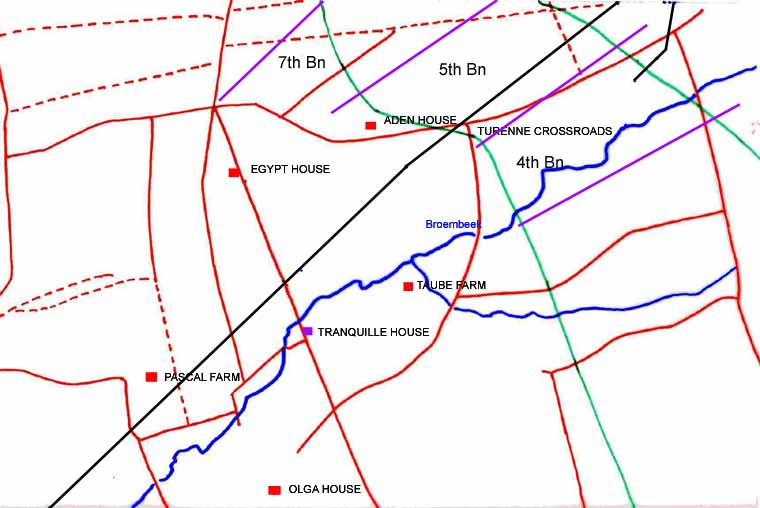
Summary of events
When 2nd Lt J.A. Burton actually laid the tape, he realised that there was only sufficient room for an attack frontage of one coy. Therefore, the front line platoon frontage was cut accordingly to one coy, the second coy was positioned to the rear of the right hand coy of the 5th Bn with instructions to wedge between the 4th and 5th Bn Coys at the front once the attack started. The third coy was held in reserve about one hundred yards to the rear of the front line coy (on a two platoon frontage) and the fourth coy under the Bn Cdr was positioned at Taube Farm 4 and Tranquille House 5.
The Coys assembled in shell holes and dug-in, in the formation described above. A piece of tape was laid to mark the boundary between the 4th and 5th Bn. Hot food was packed in hay and carried up to the coys at the assembly points.
A leap frog system of attack, recently practised in training, was to be employed. The lead platoon was to take the first objective, the second platoon was to pass through to take the second objective, the third platoon the final objective. The fourth under the company commander were to be used for counter attack or consolidation according to the tactical situation.
26th Oct 1917
At 3am heavy rain began to fall again and at 4.05am the 4th Bn reported it was in position for the attack.
At zero hour, 5.40am, the barrage opened up and began to creep forward at a rate of one hundred yards every eight minutes. The fusiliers of the149th Bde rose to their feet to advance behind it, with the 4th & 5th Bn Loyal North Lancashires (57th Divn) on the right flank and the 35th Divn on the left. Had the 'going' been good, the troops who lay close up under the barrage (so close indeed that several casualties were suffered) waiting for the first "lift", would not have had a problem advancing at the rate of the creeping barrage.
'The rain had, however, done its deadly work, for all the gallant fellows could do was to drag themselves along through the thick clinging mud and water at a much slower pace than the barrage, which soon got ahead'. Then form "pill box" and shell hole murderous fire was poured upon them. Many fell dead; some of the wounded fell into the gaping holes of water and were drowned; fortunate were those who escaped, but on went the survivors' (Wyrell. p.244).
The allied barrage consisted entirely of shrapnel and was therefore quite useless against the first objective, which consisted of concrete huts. To make matters worse the rain continued to fall heavily and the condition of mud and water were perfectly appalling.
Bn HQ received a wire from the Bde Major at 8.50am stating that a wounded Forward Observation Officer had reported that the first objective had been taken and the men were advancing well to the second objective. This information proved incorrect because 2nd Lt Wood subsequently returned wounded and reported that casualties were heavy and the attack was held up in front of the Huts. The attack had actually ground to a halt about eighty yards west of the line of huts. The machine gun fire and sniping was so severe that any further advance was quite impossible and reporting the situation back to HQ extremely difficult. Two runners were sent to the front line to try and gather information but they both failed to return.
At 11am, 2nd Lt Burton was sent forward to reconnoitre and he confirmed that the attack was held up about one hundred yards short of the Huts. At 1pm Sgt Thompson returned from the front line and confirmed 2nd Lt Burtons’ report stating that casualties were very heavy. Similar news was brought down later by Capt J.V. Gregory. This information was relayed to Bde HQ by pigeon and signaled by Lucas Lamp. Several messages were sent during the afternoon. Two platoons from the Reserve Company, under the command of 2nd Lts Peddie and Scott, were sent forward at 6pm to consolidate the original line held before the attack.
The Bn was relieved about midnight by the 4th Bn East Yorks and proceeded, via the duckboard track known as Railway Street 6, to Rose Crossroads camp 7. The 6th Bn DLI organised straggler posts in likely places to round up men returning from the front line and to guide them to camp.
Roll call revealed the appalling casualties suffered by the 4th Bn. 2nd Lts D.A. Smith, and W. Ruddy had been killed in action with 2nd Lt R.A.A. Simpson later dying of wounds. 2nd Lts G.R. Charlewood, A.W.P. Leary, H.B. Bell, J.R. Ruddock and R. Wood were wounded, and 2nd Lt R.G. Rayner and H. Stobbs were missing. Thirty-six fusiliers had been killed, one hundred and fifty-six wounded and sixty four were still missing. A total of two hundred and fifty six, more than fifty percent of those that had gone into action. The 5th Bn fared even worse with a total of 12 officers and 439 men either killed, wounded or missing. 7th Bn losses amounted to 11 officers and 246 men.
Summary compiled from 149th Bde War Diary, 4th Bn War Diary & History of the 50th Division,
Casualties
Records show that at least 100 fusiliers from the 4th Bn were actually killed in action or died of wounds between the 25th and 27th of Oct 1917. For information on 4th Bn burial and memorial sites for casualties sustained in this battle, select the link.
4th Battalion War Diary
The following is a list of points noted in the attack:-
1. Two machine guns were attached to the battalion in the attack. They went forward with the support company (in rear of 5th Bn) and did excellent work.
2. Two Stokes Mortars were to be attached but did not succeed in getting ammunition forward.
3. Communication to Bde exceptionally valuable and wonderfully maintained under a heavy barrage by the Bn. Signalling Officer (2nd Lt W.C.Clemitson) and the other signallers. The wire to 5th Bn almost instantly maintained, visual to Bde also kept up although the lamp was knocked over three times, and pigeons.
4. Wounded. Appalling difficulty in getting wounded as the slightest movement in the front line was checked by Machine Guns and sniping.
5. Liaison. Lt W.B. Hicks acted as liaison officer between the 4th Bn and the Bde on the right flank. Liaison with the 4th/5th Loyal North Lancashires maintained through 5th Northd Fus, who had an officer from that battalion with them.
6. Rations Cannot be brought up by transport in these conditions. Men must carry two days rations and also two Tommy cookers.
7. Kit as laid down appear the best, though many packs will probably be thrown away.
8. Hot food should always be carried up to the troops the night before the attack - also RUM.
9. Guiding appallingly difficult owing to the scarcity of landmarks, obvious landmarks, such as the railway are dangerous as the enemy naturally concentrates his artillery on them. We suggest a double line of pickets with plain wire on them. This is not conspicuous and very helpful.-
4th Battalion War Diary
APPENDIX C
(i) MESSAGES during the action
L.T.19 timed 12.20pm. Wounded officer left company reports attack on huts in V.1.D held up by many machine guns about 150 yards west of Huts. Right company held up in same position. Right company of SEED (5th NF) held up on same line. Impossible to work round flanks owing to swamp on right and machine guns on left. AAA. I have one company still in reserve in TAUBE FARM and TRANQUILLE HOUSE area AAA I do not propose to make another frontal attack with this company, as this appears to me to be a reliable report. AAA the officer states that Huts are very little damaged and full of machine guns AAA. Unless I receive orders to the contrary I will move Reserve Company up tonight at dusk to take over and reorganise front line AAA. Am investigating this information and will report later. AAA Ground very swampy and casualties very heavy in wounded officers company.
LT.20 timed 12.40pm In continuation of my L.T.19 I am unable to reach front line companies owing to machine gun fire and sniping from Huts and concrete emplacements. South of Huts. AAA There is not the slightest doubt that the whole attack is held up 100 to 150 yards west of Huts. I am unable to ascertain definitely position of troops on my right but they do not appear to have made much progress. AAA I am unable to estimate casualties.
LT 21 timed ? A very reliable Sgt has just brought back a report from front line. He states that 50 of our men and 2 officers are lying about 100 yards west of middle of Huts. Remainder of 3 companies, he thinks, are casualties. Total about 300. BOSCH planes have been flying low over front line shooting at them. Bosches have also sniped majority of our wounded as they tried to get back. Attack started in excellent order and was clear of BOSCH barrage before it came down – a few men succeeded in reaching HUTS but have not come back. Remainder caught by machine gun fire from HUTS and both flanks. Can you please give me assistance of large party to get our wounded out tonight with stretchers. It requires about 6 men per stretcher.
LT 22 timed 3.44pm Ref B.M.871
I am sending up 2 platoons tonight at dusk. They will consolidate original front line held before the attack and remaining 3 company’s will withdraw. I should like to send them out of the line. Is this possible please, and can staff captain arrange billets for them (probably 70 or 80 men). If the other company is not to be relieved, could you send water, rum, hot food and rations up for them and battalion HQ. Guides could meet ration parties and stretcher parties at PASCHAL FARM. I should also like a large carrying party with stretchers. Guides as above. – Sent by pigeon and substance of it by visual.
149th Bde War Diary
Speaking generally, the Bde was ordered to attack in a north-eastern direction between the southern border of the Houthhulst Forest and the Broembeek on a frontage running in an irregular manner through Aden House, and the principal objectives included "Hill 23," "Colbert Crossroads" and the groups of huts about seven hundred yards south-west of Schaap Balie. Aeroplane photographs were unfortunately not very clear, but they revealed an area that was capable of an obstinate defence, and one that might be rendered impassable by heavy rain. The chief obstacles were a double row of concrete huts or "pill-boxes," and ground that was already dangerously full of water- holes.
Heavy rain began to fall again at 3am and the "very few firm pieces of ground" became less in number; the water, trickling at first down the muddy sides of shell holes, soon became small streams, filling the occupants of the shell holes with gloomy prospects of success in the attack; pools of water widened almost to small lakes. Even in the darkness it was possible to discern stretches of water out in No Man's Land across which the attackers would have to pass.
2nd Passchendaele - Locations
1st Objective - Line of huts - approximately 300 to 400 yards distant.
2nd Objective - Approximately 500 yards distant.
3rd (Final) Objective - Colbert Crossroads and Hill 23.
Turenne Crossing - Road junction at railway crossing situated in 5th Bn front line prior to attack (Map1)
Ypres - Medieval Flemish town around which the salient formed in 1914. Known as Ieper in the Flemish language.
Bibliography
[zotpress items="HUXKQ9EA" style="harvard1"]
[zotpress items="WPX27IS4" style="harvard1"]
